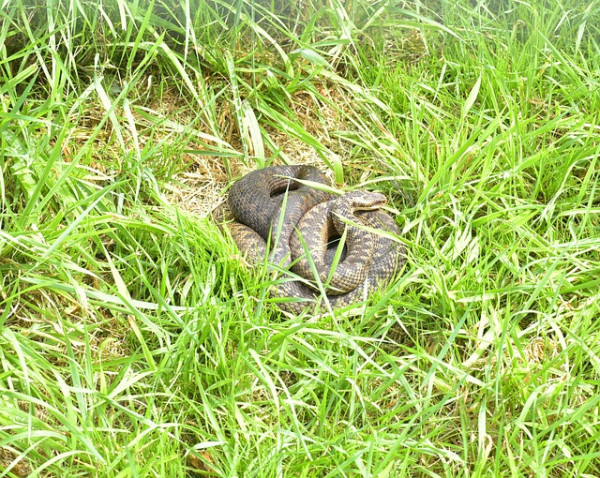We're here to help

Adder bites in dogs are scary and should be treated as a serious veterinary emergency.
Are adders dangerous to dogs?
The European adder is the only venomous snake native to the UK. Adults are up to two feet long and have a black or brown zigzag pattern along their back and a V-shaped marking on the back of their head. They can be found throughout mainland Britain, most commonly on dry sandy heaths, sand dunes, rocky hillsides, moorland and woodland edges. Unfortunately, dogs are particularly at risk of adder bites due to their curious nature.
Urgent treatment may be needed if your dog has been bitten. Contact your vet as soon as possible for advice or, out of hours, your nearest Vets Now pet emergency clinic or Vets Now 24/7 hospital
What to do if your dog is bitten by an adder
If you think your dog has encountered an adder, take him to a vet as quickly as possible. The sooner your dog sees a vet, the better their chances of making a full recovery.
- Try to stay calm. Not only will it help you, but it will help your dog stay calm.
- Carry your dog, with the bitten area elevated above the heart if possible, to reduce the spread of the snake venom around your dog’s body.
- Bathe the wound in cold water to help control the swelling.
- Keep your dog warm, but not too warm, and quiet as you transport him to the vet.
- Don’t attempt any first aid as this can do more harm than good.
- Don’t squeeze, cut or suck the wound site.
Also on this topic
How common are adder bites in dogs?
Bites are more frequent in the spring when the snakes are just out of hibernation. However, cases are also seen throughout the summer as adders become more active when the weather improves. Sometimes they can be seen basking in the sun. It’s worth bearing in mind that wild snakes are protected by law in the UK and it’s an offence to intentionally injure or kill an adder.
Adders will only bite a dog in self-defence. Generally, bites occur when a snake is stepped on or disturbed by your dog.
Signs a dog has been bitten by an adder
Most bites occur on a dog’s legs or face and typically result in a dark, painful swelling. You may also be able to see two small puncture wounds in the centre of the swelling.
Be aware that the swelling can become severe and may result in breathing difficulties, as a consequence of an allergic reaction to the toxin, particularly if your dog is bitten around the head and neck.
Your dog will also show signs of pain and may appear nervous.
Other adder bite symptoms in dogs can include pale gums, bruising, drooling, vomiting, diarrhoea, dehydration, restlessness, drowsiness, and lethargy.
Eventually, if left untreated, dogs may collapse, develop blood clotting problems, tremors or convulsions.
The severity of adder bites depends on the size of your dog, the location of the bite and the amount of venom the adder has injected. Not every strike injects venom but even dry bites, as they are known, can still cause pain, swelling and infection. It will be impossible for you to know whether your pet has received a dry bite, so your dog should be checked by a vet regardless.

Adder bite treatment for dogs
Your vet is likely to treat your dog for shock and swelling and give him pain relief. If your dog’s symptoms are severe, anti-venom may also be administered if it’s available.
Can an adder bite kill a dog?
While there have been cases where a bite has led to the death of a dog, these are very rare. One study found that fewer than one in 20 dogs died as a result of an adder bite.
However, while adder bites rarely prove fatal, they should still be treated as an emergency and your dog should be seen by a vet as quickly as possible.
How can I prevent my dog from getting bitten?
The best way to prevent adder bites on dogs is to be aware of adder hotspots in your area. Keep to paths when walking in these areas and consider keeping your dog on a leash so they don’t disturb any snakes in the undergrowth. If you do come across an adder it’s best to remain still and let it pass safely.

